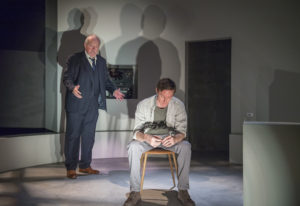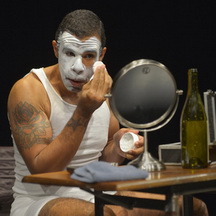British playwright Caryl Churchill’s A Number opened at the Aurora Theater’s upstairs black box, Harry’s UpStage, this past week in a fast moving production. A short thought-provoking play of five scenes with two actors, A Number calls on a wide spectrum of emotions to be put forth succinctly and powerfully. Intriguingly, Michael Gambon played Salter and Daniel Craig played the three sons in the 2002 London premier.
A Number premiered a mere six years after the successful cloning of the sheep Dolly, and enumerates many of the fears that momentous scientific breakthrough awakened in the human community. Dolly herself lived a productive, though sheltered, life, producing several offspring and seeming to have no existential angst over her unusual entry into the world of physical being.

It was not Dolly herself that caused an uproar but rather the imagined end that cloning would inevitably move us toward: the reproducing of humans from a set of cells from three different, and perhaps unwitting, donors, and consequently bypassing sex and its moral and ethical partners, love and marriage. Or at least, rendering them unnecessary. Cloning suggested science was dispensing with Nature, or playing God. And we all know that comes to no good. What the play seems to set forth are the perils not of playing God but, rather, playing God badly.
In A Number, Salter (Paul Vincent O’Connor) is confronted by his son Bernard (Joseph Patrick O’Malley) who has just found out that he is one of several Bernards, each cloned from “scrapings” of Salter’s four-year-old son. What the hospital has also told Bernard is that he is not Salter’s “original” son. They also claim that the original son does not exist. All Salter’s 21 sons are cloned. Bernard is appalled and demands an explanation. If, as his father claims, the original died in a car accident, why didn’t Salter have a son later? Why does Bernard need to share his genetic identity? He, Bernard, could have been someone else entirely. Salter’s answer is to sue the hospital. There shouldn’t have been extra Bernards. The doctors have weakened his identity. Salter offers to put a number on the value of Bernard’s individuality. Should they sue for $20,000? $100,000? Half a million? How much is uniqueness worth?
Bernard is less concerned that there are more Bernards walking around, eating, drinking, talking and laughing. What, he wonders and fears, is the depth of their similarity? If they all bought dogs, would the dogs all be the same breed? Would they give their dogs the same name? There is a subtle current of dark humor running beneath the anger and accusations.
Bernard is unhappy, righteously angry. His father’s claim that he loves him goes unremarked, as does his father’s explanation that his original son was so perfect that he couldn’t lose him when he died.
When the lights come up on scene two, Salter is facing a different Bernard (also played by O’Malley), in a khaki T-shirt, his hair awry. This Bernard is slightly older, and he too has found out that he has twins. Only this Bernard is seriously pathological. Someone, we fear, and rightly, is in danger. What we also discover is that this Bernard is the original, contrary to what the hospital has told Bernard #1. Why Salter abandons this son for another is surely the true, unasked moral and ethical dilemma of the play.
And there is a third clone, Michael, raised by someone else entirely and who closes the play in a different and surprisingly upbeat note.
The play is staged in sets describing a small, stark, white room that could be an office. A low circular wall separates the actors and the action from the audience. The circular motif, like the several shadows that are cast by the actors on the back of the sets, gives the stage a cage-like feel and a sense that players are stuck in a life looping over and over in repetitions with multiple small changes. Set design was by Michael Locher; Jim Cave did the lighting. Everything was compactly directed by Barbara Damashek.
–Jaime Robles
Caryl Churchill’s A Number continues at the Aurora Theater through May 6. For tickets and information, visit auroratheatre.org.
